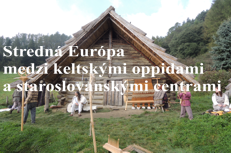PhD studies topics starting in 2023. For further information, you can find it here: https://www.ff.ukf.sk/23-studium/doktorandske-studium
Faculty of Arts, Constantine the Philosopher University in Nitra, 3 years
Historical sciences, study programme: Archaeology
1st topic: Settlement structure of Lower Hron river and Ipeľ river valleys from the Neolithic till the Hallstatt Period in light of human-landscape interactions
Supervisor: prof. PhDr. Jozef Bátora, DrSc. (Contact: nraubato@savba.sk)
Consultant: PhDr. Vladimír Mitáš, PhD. (Contact: vladimir.mitas@savba.sk)
Application deadline: 15th August
Date of admission: 30th August
Abstract: During prehistory of the northern part of Carpathian Basin, Lower Hron and Ipeľ regions constituted a bridge between Danubian Lowland and Tisza Basin. The aim of the dissertation should be, besides the identification of cultural changes, settlement structure and dynamics in this area, to analyse changes arising due to interactions of the human, landscape and natural environment. The dissertation will require broader interdisciplinary cooperation.
2nd topic: Early medieval settlement (6th–11th c.) of the Middle Nitra Basin from the perspective of archaeology
Supervisor: Mgr. Zbigniew Robak, PhD. (Contact: zbigniew.robak@savba.sk)
Consultant: doc. PhDr. Matej Ruttkay, DrSc. (Contact: matej.ruttkay@savba.sk)
Application deadline: 15th August
Date of admission: 30th August
Abstract: The aim of the thesis is to collect and evaluate archaeological sources from the given chronological period from the central Nitra area and from the adjacent mountains – Vtáčnik, Strážovské Vrchy, Považský Inovec and Tribeč. The work will include documentation and processing of findings deposited in several institutions, as well as work in the GIS environment and with the use of LIDAR data.
3rd topic: Everyday life in the castle in the Middle Ages and the postmedieval period
Supervisor: PhDr. Peter Bednár, CSc. (Contact: peter.bednar@savba.sk)
Application deadline: 15th August
Date of admission: 30th August
Abstract: Elaborating knowledge about everyday life in castles in the Middle Ages and postmedieval period (13th-17th centuries) based on the findings from the more recent archaeological research of castles in eastern Slovakia. The focus of the proposed work would be the processing of finds from the Castle Vinné (Michalovce district) and the Krásna Hôrka Castle (Rožňava district).
4th topic: Medieval and modern ceramics from the upper Žitava river valley based on the archaeological sources from Hrušov and Gýmeš castles
Supervisor: Mgr. Mário Bielich, PhD. (Contact: nraubedn@savba.sk)
Application deadline: 15th August
Date of admission: 30th August
Abstract: The aim of the thesis is the processing and evaluation of ceramic finds from archaeological research of the castles of Hrušov and Gýmeš in the context of archaeological sources from Upper Žitava Valley and in a wider context also from the surrounding areas of historical Hungary. The aim is also to capture the changes that took place in the production of ceramics in the time period under study, as well as to recognize imports of different provenance in ceramic assemblages.
5th topic: Central hillfort of the Púchov culture on Havránok hill in Liptovská Sielnica-Liptovská Mara. Development, function, and heritage presentation
Supervisor: PhDr. Karol Pieta, DrSc. (Contact: nraupiet@savba.sk)
Consultant: Mgr. Lucia Benediková, PhD. (Contact: nraubene@savba.sk)
Application deadline: 15th August
Date of admission: 30th August
Abstract: The topic includes the development of the use and interpretation of the importance of the dominant site of the Liptovská basin – the hill Liptovská Mara – Havránok in the protohistoric period based on the rich materials from the long-term excavations of the Institute of Archaeology of the Slovak Academy of Sciences (SAV). The hill was fortified and used as an important sacrificial place from the Middle La Téne to the beginning of the Roman period. The topic will also include reconsideration of the reconstruction of selected archaeological features and the use of the site for cultural tourism



